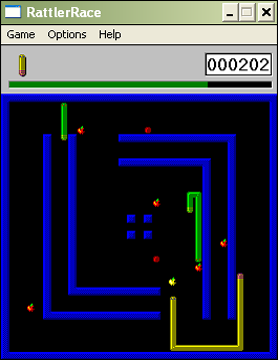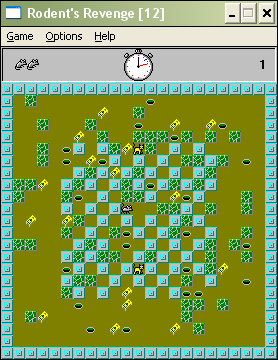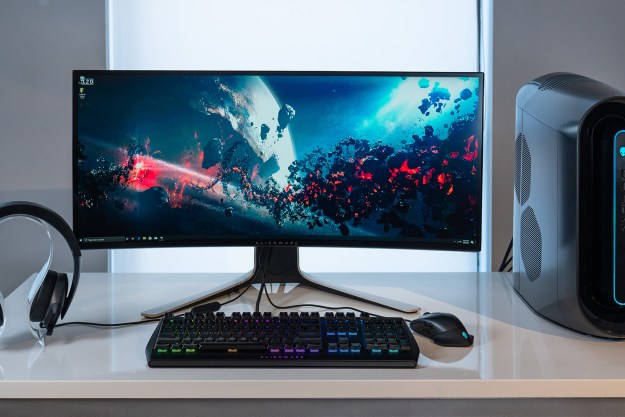
In the early days of its existence, however, the PC was a separate entity to the world of video games, and struggling to find big-name games. Microsoft decided to combat that with games developed in-house that proved the PC’s value for entertainment and made the operating system more approachable.
The Microsoft Entertainment Pack was launched in 1989 to expose users to the fun side of Windows. For many, the simple but enjoyable games found in the Entertainment Pack provided a first taste of early PC gaming and served as a gateway to more complex classics.
Rodent’s Revenge
While the original 1989 Microsoft Entertainment Pack brought early versions of Windows mainstays like Minesweeper and Mahjong, other games earned a place in user’s hearts. One of those games, Rodent’s Revenge, was the work of Chris Fraley, who grew up playing games like Galaxian, Robotron and Berserk.
Chris’ father worked at Bell Labs, the research and scientific development facility that is credited with the creation of the UNIX operating system and the C programming language, among other accomplishments. One day, he purchased a Commodore PET and brought it back to the family home — and, immediately, Chris was hooked. “He never got to use the computer,” Chris says of his father’s purchase. “My older brother and I took to it like fish to water.”

The Fraley boys monopolized the family computer, but they put their time with it to good use. Soon, the pair were selling a cassette loaded with their games to readers of a PET user group newsletter. Chris also put together “at least 10” early versions of the game that would one day be known to a broad swath of Windows users as Rodent’s Revenge.
However, it would take a few years until Chris was in a position to make that game a reality. That opportunity came about once he was working for Microsoft, as he was alerted to the possibility of one of his games being part of the company’s entertainment compilation. “A colleague of mine had submitted a game to the Entertainment Pack,” he tells me. “So when I heard through the grape-vine that a second was planned, I submitted Rodent’s Revenge.”
The game was accepted, and based on the strength of it, Fraley’s version of a snake game was included as RattlerRace after that game’s original designer dropped out. Like many of the titles included in the various Microsoft Entertainment Pack releases, both games look dated today, but the gameplay endures.
“I come across a lot of folk who have played them and enjoyed them back in the day,” Chris said, but he noted that this sort of communication has become less common because his games don’t run on Windows 7 or 8. Still, there’s a surprising group of dedicated fans remaining who still send fan mail years after Fraley’s games last appeared.
“One of particular note was a letter from a woman in a nursing home,” Chris recalled. She expressed her love for Rodent’s Revenge and was eager to pick his brains for any hints and strategies he had hidden away. “She wanted to let me know how she found that using the computer was much more enjoyable after learning to play the game.”
It seems, then, that Fraley’s games did exactly what they were meant to. The Microsoft Entertainment Pack was designed to make PCs more approachable for new users. Rodent’s Revenge managed to accomplish exactly that.
Chip’s Challenge
Chip’s Challenge, another Microsoft Entertainment Pack classic, was originally released for the Atari Lynx handheld game system in 1989, but reached its greatest audience on home computers. People loved the game so much that its biggest fans developed a version of its game engine for use with community-sourced level packs, leading many to ask why its creator, Chuck Somerville, didn’t simply develop a sequel of his own. The answer? He did! But releasing it proved more difficult than developing it.
“I was simply trying to be an indie too early,” Chuck said. “Fans of Chip’s Challenge were so passionate that they kept on asking me if I’d make a sequel, so in my own spare time I spent about two years making Chip’s Challenge 2.” Chuck had been given consent to begin development by the publisher of the original, but the agreement changed once the game was ready for release.
“They changed the rules and asked me to front all of the marketing costs — about $100,000. I simply couldn’t afford it,” Chuck says when I ask him why the sequel never made it to fans. “I was very sad about it for a long time.” Thankfully, that wasn’t to be the end of Chip’s Challenge.
Last year, Chuck teamed with Niffler to release Chuck’s Challenge 3D, a modern take on the classic gameplay that made the original a hit. As well as a host of newly designed stages by Somerville himself, one of the biggest draws of this new game was its robust level editor designed to make it easy for fans to create challenges for themselves. “I love that people make levels that are so hard I get stumped.”
Chuck’s Challenge 3D is a product of today’s gaming landscape; it’s a digital release that has been buoyed post-launch by a steady stream of user-generated content as well as updates from its designer. For Chuck, it’s a potent reminder of just how much the industry had changed since he was first setting out. “Chip’s Challenge was originally made in 10 weeks, whereas Chuck’s Challenge 3D has been in development for over 4 years,” he said. “Watching Chuck’s Challenge 3D continually grow with the community is something that makes me smile, and think it has all been worth it.”

The success of Chuck’s Challenge 3D has allowed Somerville to take a step back into the past. It seemed all but certain that Chip’s Challenge 2 would never see release, but later this month it will finally be made available to fans via Steam alongside its predecessor. For Chuck, it’s an opportunity to let his fans finally enjoy a game he was hard at work creating some two decades ago. “I had to count it as one of those life lessons and walk away,” Chuck said — but now, that’s no longer that case.
Tetris
When you think of Tetris, the name that immediately comes to mind is likely Alexey Pajitnov, the man who created the classic puzzler. However, the game likely would never have become as popular as it did without the efforts of Henk Rogers.
Over the course of a thirty-year career in the video games industry, Henk ran the gamut from programming and design to the world of publishing. During that time he was involved with two of the more well-known titles to be included in Microsoft Entertainment Pack releases; Pipe Dream and Tetris.
Tourists were not supposed to do any kind of business with anyone in the Soviet Union. I broke all the rules.
“I licensed Pipe Dream from LucasArts,” Henk said. He stayed at George Lucas’ Skywalker Ranch to negotiate the deal. “At the time, there was a kind of feeding frenzy looking for the next Tetris. I won the competition. But Pipe Dream was not the next Tetris.” Pipe Dream made its way to the Pack, but there was still room for a top-notch, rapid-fire puzzler. Henk decided to stop trying to find a replacement and go straight to the source.
Throughout the 1980s, the rights to Tetris were in flux. By the time Henk got involved, they were being held by a company called Elektronorgtechnica — ELORG for short — which was owned by the Soviet state. “I went without a visa, not knowing how to find ELORG,” said Henk. “Tourists were not supposed to do any kind of business with anyone in the Soviet Union — think North Korea. I broke all the rules, and did everything anyway.”
Henk told me about the ways that he juked the conventions of doing business in Soviet Russia, drawing on his considerable experience working in the United States and Japan. “I taught them how we do business, from serving tea and cookies to fairness in contracts,” he told me. “I even brought them a fax machine, so we could communicate for my second visit.” The first trip snagged him worldwide rights to the game on handheld systems. A month later, he returned to finalize the console rights.

Years later, Alexey Pajitnov’s deal with ELORG came to an end, and he turned to Henk to help him retain ownership of his creation. “I went to bat for my friend, Alexey, and we’ve been partners ever since,” Henk states, clearly proud of a job well done. “In the end, I ended up buying ELORG, and controlling all of the Tetris rights.”
The version of Tetris released as part of the Microsoft Entertainment Pack had little to do with Henk — it was licensed in 1990 via ELORG. However, his work to secure the rights to the franchise was part of a larger movement towards the protection of intellectual properties in the industry. Given that various titles released as part of the Microsoft Entertainment Pack were clones of some sort, his efforts may well have had a massive impact on the feasibility of further releases for Microsoft. The video game industry was growing up, and the company would soon have to change its strategy with regards to the blossoming world of PC gaming.
Lasting Impact
The story behind Microsoft’s Entertainment Pack is a glimpse into the pioneer days of video game development for Windows. On the one hand, Chris Fraley had the chance to make good on his childhood ambition to create a video game — and, on the other, there’s the story of Chuck Somerville turning video game design into a career.
Chuck’s story also reveals the underbelly of early relations between bedroom programmer and their publisher. Fortunately, a figure like Henk Rogers should be enough to convince you that there are publishers out there who have the interests of the creator in mind.
Video game development today is as accessible as it ever has been. With enough commitment, a skilled amateur can have a game available for sale on a platform like Steam in a matter of months. A host of programmers, designers and publishers paved the way for the indie developers of today — and, without releases like the Microsoft Entertainment Pack that helped cultivate both the talent and audience, the future of PC gaming might not be as bright as it is today.
Editors' Recommendations
- Age of Mythology: Retold will launch on PC and Xbox at the same time
- HyperX just made your next favorite gaming keyboard
- Windows is holding back the future of handheld gaming
- Windows 11 is about to make RGB peripherals way easier to use
- Are Windows 11 security features killing your gaming performance? You might be surprised






